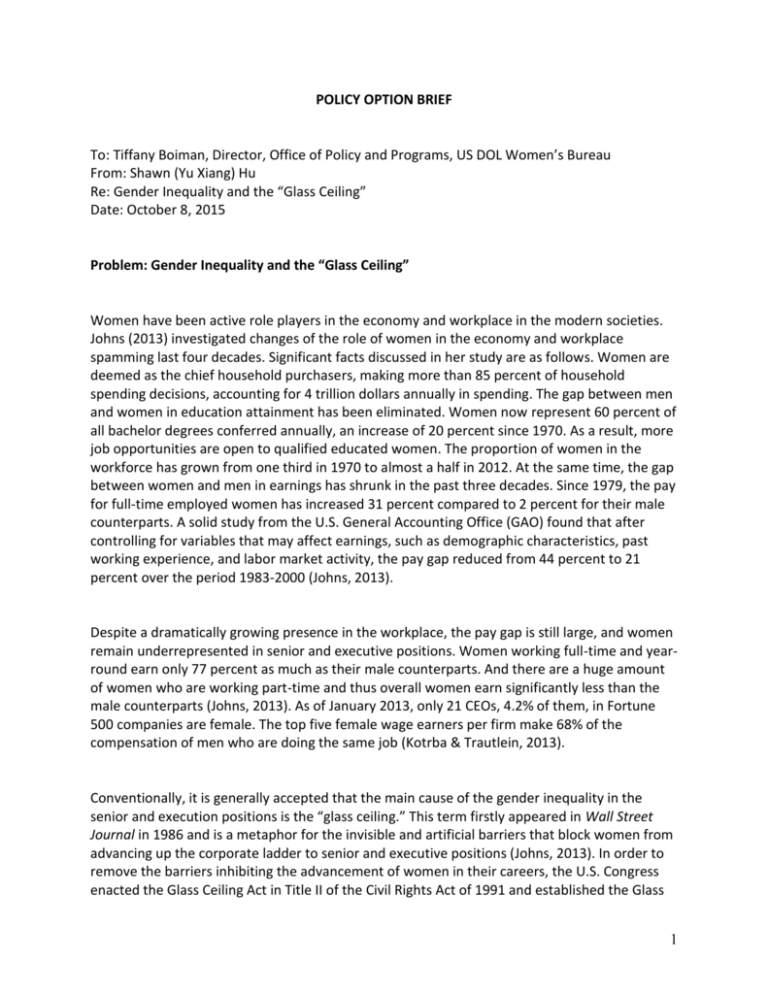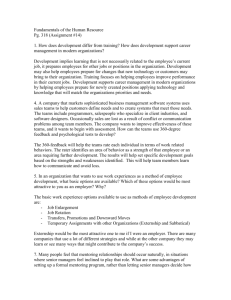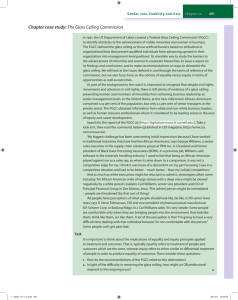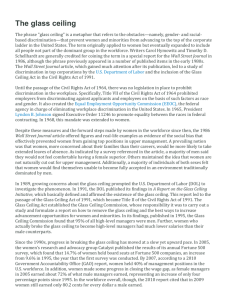Policy Option Memo – The _Glass Ceiling_ShawnHu
advertisement

POLICY OPTION BRIEF To: Tiffany Boiman, Director, Office of Policy and Programs, US DOL Women’s Bureau From: Shawn (Yu Xiang) Hu Re: Gender Inequality and the “Glass Ceiling” Date: October 8, 2015 Problem: Gender Inequality and the “Glass Ceiling” Women have been active role players in the economy and workplace in the modern societies. Johns (2013) investigated changes of the role of women in the economy and workplace spamming last four decades. Significant facts discussed in her study are as follows. Women are deemed as the chief household purchasers, making more than 85 percent of household spending decisions, accounting for 4 trillion dollars annually in spending. The gap between men and women in education attainment has been eliminated. Women now represent 60 percent of all bachelor degrees conferred annually, an increase of 20 percent since 1970. As a result, more job opportunities are open to qualified educated women. The proportion of women in the workforce has grown from one third in 1970 to almost a half in 2012. At the same time, the gap between women and men in earnings has shrunk in the past three decades. Since 1979, the pay for full-time employed women has increased 31 percent compared to 2 percent for their male counterparts. A solid study from the U.S. General Accounting Office (GAO) found that after controlling for variables that may affect earnings, such as demographic characteristics, past working experience, and labor market activity, the pay gap reduced from 44 percent to 21 percent over the period 1983-2000 (Johns, 2013). Despite a dramatically growing presence in the workplace, the pay gap is still large, and women remain underrepresented in senior and executive positions. Women working full-time and yearround earn only 77 percent as much as their male counterparts. And there are a huge amount of women who are working part-time and thus overall women earn significantly less than the male counterparts (Johns, 2013). As of January 2013, only 21 CEOs, 4.2% of them, in Fortune 500 companies are female. The top five female wage earners per firm make 68% of the compensation of men who are doing the same job (Kotrba & Trautlein, 2013). Conventionally, it is generally accepted that the main cause of the gender inequality in the senior and execution positions is the “glass ceiling.” This term firstly appeared in Wall Street Journal in 1986 and is a metaphor for the invisible and artificial barriers that block women from advancing up the corporate ladder to senior and executive positions (Johns, 2013). In order to remove the barriers inhibiting the advancement of women in their careers, the U.S. Congress enacted the Glass Ceiling Act in Title II of the Civil Rights Act of 1991 and established the Glass 1 Ceiling Commission. The commission identified three main sources contributing to the “glass ceiling”: social barriers, internal structural barriers, and governmental barriers. Societal barriers are those outside of the direct control of business. Women are overrepresented in low-wage occupations, in part-timer and seasonal jobs and lack the opportunities to advance to higher positions. Stereotype and prejudice also exist that men have better leadership skills and competencies than women. A deficiency theory describes that women lack qualities necessary for leadership (Morrison & von Glinow, 1990). Many corporations, especially those in the male-dominated industries, have formed the corporate culture that senior and executive positions should be filled by white men. A woman stepping into the board would make her counterparts uncomfortable. In contrast, internal business barriers are within the direct control of business. Corporations may not equally reach or recruit men and women in their outreach and recruitment practices. In addition, corporate climates may not promote the inclusion of women in the senior and executive positions. The Federal Glass Ceiling Commission reported that many middle- and upper-level white male managers perceived that the inclusion of women in management was a direct threat to their own chances for advancement (U.S. Glass Ceiling Commission, 1995). In order to remove the internal business barriers, corporate leaders should be aware of the fact that the goal of corporations is to maximize the profitability by hiring the right persons regardless of gender. Governmental barriers also worsen gender inequality in the career advancement. Title VII of the Civil Rights Act of 1964 protects individuals from discriminating based upon sex. This law makes it illegal for an employer to discriminate against individuals because of their sex in hiring, firing, and other terms and conditions of employment, such as promotion, raises, and other job opportunities (Workplace Fairness, 2015). However, the Glass Ceiling Commission reported that the effectiveness of law enforcement in equal employment opportunities would be weak if no government monitoring or sanction was in place (U.S. Glass Ceiling Commission, 1995). Few people can deny the existence of “glass ceiling” in today’s business world. However, nowadays the mainstream tends to believe that women underrepresenting in the senior and executive positions can only be partially explained by “glass ceiling.” Since the barriers in education and employment have been largely eliminated for women, “glass ceiling” is no longer a major cause to gender inequality in the leadership and management practices in business. Instead, influenced by their personal and family factors, women are stuck in the “sticky floor,” women’s self-imposed career blocks that keep women stuck near the bottom half of the ladder (Modell, 2013). Alice Eagly, a psychology professor at Northwestern University, argues that gender inequality in the workplace has been profound misleading because the challenges that 2 women face in having successful careers are not just at the top, but exist all the way along the career (Big Think, 2011). Women are stuck in the “sticky floor” mainly due to the motherhood. Women are distracted from their careers by the need to stay at home and rear children. Despite of the equal opportunities to education and employment, more women choose to participate in nonmarket, unpaid household activities, while more men involve in market, paid activities outside of the household. Such a division of labor complies with the culture and customs in most of the societies. Economists also argue that such a division of labor can achieve specialization by men and women utilizing their comparative advantages. By assuming the major responsibilities within the household, women who are working full-time find themselves struggle in keeping work-life balance. The lack of role models makes the floor even sticker. Kanter (1977) claimed that managerial women were only tokens, representing female employees in their workplace. A very small portion of women is placed in the high-level positions just to generate a symbolic effect. These representatives, or tokens, function to give the appearance of gender equality within a workforce. In such a case, the discrimination practices against women are hidden. There are too few successful women who can support and advocate other women to advance their careers. “Leaky pipeline” is also frequently used to describe the phenomenon that women drop out of the STEM fields at all stages of their careers. The metaphor of “leaky pipeline” can be a reflection of both “glass ceiling” and “sticky floor.” Women in the STEM fields suffer more overt and covert discrimination compared to those in other fields. It has been proved that both male and female faculty tends to recruit male laboratory managers and men have a statistically significant higher pay than women in the STEM fields (Moss-Racusin et. Al, 2012). Highly ranked women are even much rarer in the STEM fields. They become anomalies, lack support from colleagues and face antagonism from peers and supervisors (Lips, 1988). From the perspective of economics, women are very important human capital and currently they are under-utilized. The most critical consequence of blocking women to step in the senior and executive positions is a waste of human capital. Given that nowadays women have equal opportunities for education and employment, they also have comparable competencies to lead corporations to succeed. The current condition that capacities and knowledge of qualified women are not fully utilized causes a gap between actual GDP and its potential level. The American Humanagement Association has proven that the “glass ceiling” is not only unfair but also costly. An audit of a Fortune 500 utility company revealed that the company’s hidden costs of gender bias could amount to as large as $15.3 million (Stuart, 1992). 3 Policy Options Policy adjustment are necessary to reduce gender inequality in the senior and executive positions. This section will provide several policy options that may sooth the problem identified in this paper as follows: pass the Paycheck Fairness Act; pass the Fair Pay Act; and improve childcare benefits and career training. Pass the Paycheck Fairness Act The Paycheck Fairness Act (PFA) is a proposed law that aims at strengthening the law enforcement to the Equal Pay Act (EPA) of 1963. The goal of the PFA is to reduce the income disparity in the United States between men and women. Therefore, the PFA reflects the same belief imbedded in the EPA: “Equal Pay for Equal Work.” But the PFA would add significant burdens on employers to demonstrate that wage differentials are based on factors other than sex. It also prohibits retaliation against workers who disclose their own wages, and strengthens penalties for equal pay violations, exposing employers to the possibility of unlimited damage. In addition, the proposed PFA responds to the critics on the poor law enforcement and low efficiency of the government agencies. It directs the Department of Labor to assist employers and collect wage-related data. The Equal Employment Opportunity Commission staff will be provided additional training and support so as to better identify and handle wage disputes (ACLU, 2013; Paycheck Fairness Act, 2013). It is worth noted that the PFA does not amend the EPA’s “equal work” standard. Siniscalco, Damrell, and Nabity (2014) argue that the “equal work” standard is of little use to solve the “glass ceiling.” The work in the senior and executive roles are rarely “equal” for the purpose of the EPA. Many courts have also recognized that the EPA is the wrong vehicle for litigating wage disparities among high-level professional and executives (Siniscalco, Damrell, and Nabity, 2014). The Southern District of New York rejected an EPA claim premised on differences in pay among professionals with the same job title (EEOC v. Port Auth. Of N.Y. & N.J., 2012). In this case, EEOC alleged that female Port Authority attorneys were paid less than male colleagues despite performing the same work. The court granted the Port Authority’s motion for judgment on the pleadings, finding that relying primarily on attorneys’ job titles along with broad generalities about attorneys’ skills and training is “simply not a sufficient basis in which to premise an EPA claim.” Another illustration is from a Wisconsin district court. In this case, despite sharing some similarities, the differences between a city’s treasurer and its comptroller precluded the plaintiff’s EPA claim (Campana v. City of Greenfield, 2002). The district court granted that both officials led city departments and managed city finances. However, the roles were “comparable, ‘counterpart’ positions,” not equal positions, which is not enough to prevail on an EPA claim. 4 Pass the Fair Pay Act Unlike the PFA and EPA, the proposed Fair Pay Act (FPA) is to require employers to provide equal pay for work of equal value, instead of “equal work.” The FPA, introduced to Congress since 1995 but never passed, goes beyond the EPA with its underlying “comparable worth” theory. Under such a theory, employers should provide equal pay for men and women not only in “comparable” jobs, those that “may be dissimilar, but whose requirements are equivalent, when viewed as a composite of skills, effort, responsibility, and working conditions” (Fair Pay Act of 2013). Compared to the EPA, FPA is better-suited for non-standardized, high-level jobs, beause such positions do not, almost by definition, require equal skill, effort, and responsibility, performed under equal working conditions (Siniscalco, Damrell, and Nabity, 2014). FPA appears to be a better option to address the “glass ceiling.” However, FPA also has its flaws. Whether the jobs are comparable is subjective. At any given time, individual employers have their own values and judge whether jobs are comparable and deserved for equal pay. When dispute arises, the decision made by judges and juries also dominates objective criteria. To standardize the decision-making process, the government will have to collect sufficient data, and posit each of job features, skills, and working conditions in a scale system. Each specific job will be graded and assigned a score based on such features, skills, and working conditions it requires. Such massive work sounds impractical and very expensive. The biggest issue underlying such a system is that it will distort the labor market and intervene the market-oriented economy in the U.S. Improve Childcare Benefits and Career Trainings When the gender equality advocates push the government to strengthen antidiscrimination laws, discrimination may not be the main source of gender inequality suggested by the cause analysis in the Problem Session of this policy brief. “Sticky floor” and “leaky pipeline” can also induce gender segregation and the pay gap. Besides safeguarding the workers’ rights, there are additional initiatives that the government could introduce to promote gender equality. The government can provide more generous childcare support to those in need. As reflected by the 2010 OECD study, the United States offers far less childcare support and parental leave benefits than other OECD countries (Siniscalco, Damrell, and Nabity, 2014). With more resources at hand, mothers can have a more flexible budget to raise their children as well as go out to work. Equal parental leave benefits for both fathers and mothers can also significantly change the structure of labor supply. When a child is newly born, both parents can in turn utilize their parental leave benefits to raise the child. The time leaving the workforce due to 5 child care will not burden on the only one side. As a result, women’s career path will become smoother. The government could also improve training to reduce gender segregation in the workplace. The Institute for Women’s Policy Research (IWPR, 2013) found that a government training program funded by Workforce Investment Act (WIA) may in fact deteriorate gender segregation and the pay gap. The IWPR finds that currently more than two million Americans are receiving such training services annually. However, both men and women are inclined to receive training services for the jobs dominated by their own gender. Since the traditional male-dominated jobs are higher paid, such a program design not only contributes to gender segregation but also the pay gap. The IWPR suggests that more proactive career counseling may encourage women to enter higher earning fields. The government could also offer negotiation skills training to girls and women. In fact, PFA already has a provision to implement such training. But the government needs not to implement it until the bill is signed into law (Paycheck Fairness Act, 2013). Equipped with better negotiation skills, women can understand their rights and know how to negotiate for better benefits in the workplace. To what extent the government offers childcare benefits and improved career training programs is subject to the budget constraints. Further research will be required to quantify the effect of such childcare benefits and career trainings on reducing the gender gap in the workplace. 6 References American Civil Liberties Union (ACLU),. (2013). Equal Pay for Equal Work: Pass the Paycheck Fairness Act. Retrieved 8 October 2015, from https://www.aclu.org/equal-pay-equalwork-pass-paycheck-fairness-act Big Think,. (2011). The "Glass Ceiling" Is Misleading. Retrieved from https://www.youtube.com/watch?v=tLKQezaz2IA Campana v. City of Greenfield, (2002). 164 F. Supp. 2d 1078, 1090-91 (E.D. Wis. 2001), aff’d, 38 F. App’x. 339 (7th Cir.) EEOC V. Port Auth. of N.Y. & N.J., (2012). No. 10 Civ. 7462 (NRB), 2012 U.S. Dist. LEXIS 69307, at *13. Fair Pay Act,. (2013). H.R. 438, 113th Cong. Institution for Women’s Policy Research (IWPR),. (2013). Workforce investment system reinforces occupational gender segregation and the gender wage gap. Johns, M. (2013). Breaking the glass ceiling: Structural, cultural, and organizational barriers preventing women from achieving senior and executive positions. Perspectives In Health Information Management, 10(Winter). Retrieved from http://www.ncbi.nlm.nih.gov/pmc/articles/PMC3544145/ Kanter, R. (1977). Men and women of the corporation. New York: Basic Books. Kotrba, L., & Trautlein, B. (2013). Demystifying the glass ceiling: A closer look at women in leadership. Retrieved from https://www.youtube.com/watch?v=ev1Cm_uKSoM Lips, H. (1988). Sex & gender. Mountain View, Calif.: Mayfield Pub. Co. Modell, R. (2013). The ‘Sticky Floor’ Revisited. The Glasshammer. Retrieved 17 September 2015, from http://theglasshammer.com/2013/04/17/the-sticky-floor-revisited/ Morrison, A., & von Glinow, M. (1990). Women and minorities in management. American Psychologist, 45(2), 200-208. doi:10.1037/0003-066x.45.2.200 Moss-Racusin, C., Dovidio, J., Brescoll, V., Graham, M., & Handelsman, J. (2012). Science faculty's subtle gender biases favor male students. Proceedings Of The National Academy Of Sciences, 109(41), 16474-16479. doi:10.1073/pnas.1211286109 Paycheck Fairness Act,. (2013). S. 834, 113th Cong. 7 Siniscalco, G., Damrell, L., & Nabity, C. (2014). The pay gap, the glass ceiling, and pay bias: Moving forward fifty years after the equal pay act. American Bar Association Labor & Employment Law Journal. 29(3). Stuart, P. (1992). What does the glass ceiling cost you?. Personnel Journal, 1992(Nov), 70+. Retrieved from http://go.galegroup.com/ps/i.do?id=GALE%7CA13930764&v=2.1&u=cuny_baruch&it =r&p=ITOF&sw=w&asid=330be8143a96dcddda31b9f8dfb U.S. Glass Ceiling Commission,. (1995). Good for business: Making full use of the national's human capital. Washington, DC: U.S. Government Printing Office. Retrieved from http://digitalcommons.ilr.cornell.edu/key_workplace/116/ Workplace Fairness,. (2015). Sex / Gender Discrimination. Workplacefairness.org. Retrieved 17 September 2015, from http://www.workplacefairness.org/sexual-genderdiscrimination 8




